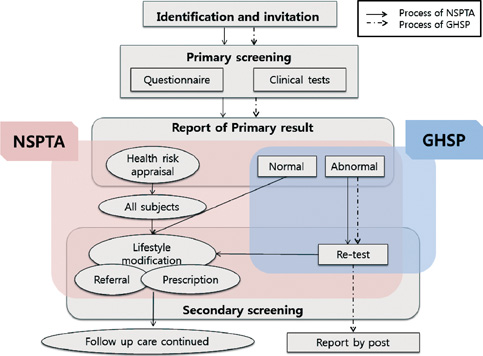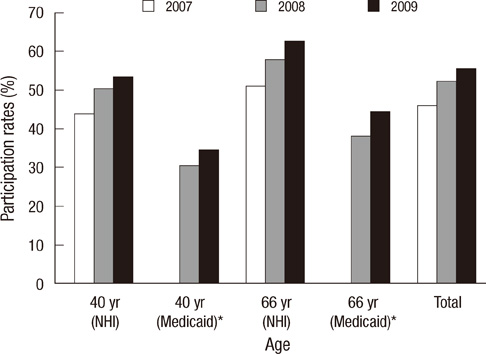National Screening Program for Transitional Ages in Korea: A New Screening for Strengthening Primary Prevention and Follow-up Care
- Affiliations
-
- 1Department of Family Medicine, Seoul National University College of Medicine, Seoul, Korea. belong@snu.ac.kr
- 2Department of Preventive Medicine, The Catholic University of Korea College of Medicine, Seoul, Korea.
- 3Division of Chronic Disease Control, Korea Centers for Disease Control and Prevention, Osong, Korea.
- KMID: 1714491
- DOI: http://doi.org/10.3346/jkms.2012.27.S.S70
Abstract
- Screening can effectively reduce mortality and morbidity in some diseases. In Korea, a practical national screening program for chronic disease was launched in 1995 and several problems were discussed. The program focused primarily on disease detection without follow-up care. In addition, the test items were uniform regardless of subject's age, sex, or risk factors; and people with low socioeconomic status were excluded. To improve the quality of program, a new national screening program called the "National Screening Program for Transitional Ages (NSPTA)" was initiated in 2007. It targeted two age groups, ages 40 and 66, because these ages are important transition periods in one's lifecycle. Follow-up care and education for lifestyle modification has been intensified; screening tests for mental health problems and osteoporosis have been introduced. The pool of eligible participants has been expanded to include people supported by Medicaid. This review aimed to describe the contents, process, and characteristics of the NSPTA and to compare it with the previous program. In addition, some preliminary results from 2007 to 2009 were presented. Lastly, we suggest several points that need to be considered to improve the program such as enhancement of participation rates, necessity of specialized committee and research for current screening program to be supported by evidence.
Keyword
MeSH Terms
Figure
Cited by 6 articles
-
Utilization of Osteoporosis-Related Health Services: Use of Data from the Korean National Health Insurance Database 2008–2012
Tae Yang Yu, Hyemin Cho, Tae-Young Kim, Yong-Chan Ha, Sunmee Jang, Ha Young Kim
J Korean Med Sci. 2018;33(3):. doi: 10.3346/jkms.2018.33.e20.A Comparative Evaluation of the KDSQ-C, AD8, and SMCQ as a Cognitive Screening Test to Be Used in National Medical Check-ups in Korea
Ahro Kim, SangYun Kim, Kyung Won Park, Kee Hyung Park, Young Chul Youn, Dong Woo Lee, Jun-Young Lee, Jun Hong Lee, Jee Hyang Jeong, Seong Hye Choi, Hyun Jeong Han, Semi Kim, Seunghee Na, Misun Park, Hyeon Woo Yim, Dong Won Yang
J Korean Med Sci. 2019;34(14):. doi: 10.3346/jkms.2019.34.e111.Association between Timed Up and Go Test and Subsequent Functional Dependency
Ji Eun Lee, Hyejin Chun, Young-Sang Kim, Hee-Won Jung, Il-Young Jang, Hyun-Min Cha, Ki Young Son, Belong Cho, In Soon Kwon, Jong Lull Yoon
J Korean Med Sci. 2020;35(3):. doi: 10.3346/jkms.2020.35.e25.Effects of Disease Detection on Changes in Smoking Behavior
Jeoung A Kwon, Wooman Jeon, Eun-Cheol Park, Jae-Hyun Kim, Sun Jung Kim, Ki-Bong Yoo, Minjee Lee, Sang Gyu Lee
Yonsei Med J. 2015;56(4):1143-1149. doi: 10.3349/ymj.2015.56.4.1143.Urinary Incontinences Are Related with Fall and Fragility Fractures in Elderly Population: Nationwide Cohort Study
Hye-Jin Kim, Jin-Woo Kim, Soong-Nang Jang, Kyung Do Kim, Jun-Il Yoo, Yong-Chan Ha
J Bone Metab. 2018;25(4):267-274. doi: 10.11005/jbm.2018.25.4.267.10-Year Fracture Risk in Postmenopausal Women with Osteopenia and Osteoporosis in South Korea
Yeon-Hee Baek, Sun Wook Cho, Han Eol Jeong, Ju Hwan Kim, Yunji Hwang, Jeffrey L. Lange, Ju-Young Shin
Endocrinol Metab. 2021;36(6):1178-1188. doi: 10.3803/EnM.2021.1215.
Reference
-
1. Wald NJ. Guidance on terminology. J Med Screen. 2008. 15:50.2. Leavell H, Clarke E. Preventive medicine for the doctor in his community. An epidemiologic approach. 1965. 3rd ed. New York: McGraw-Hill.3. Criteria for appraising the viability, effectiveness and appropriateness of a screening programme. UK National Screening Committee. accessed on 1 October 2011. Available at http://www.screening.nhs.uk/criteria.4. Screening programmes across the UK. UK National Screening Committee. accessed on 1 October 2011. Available at http://www.screening.nhs.uk/programmes.5. The guide to clinical preventive services 2010-2011. U.S. Preventive Services Task Force. accessed on 1 October 2011. Available at http://www.USPreventiveServicesTaskForce.org.6. The Canadian guide to clinical preventive healthcare. Public Health Agency of Canada. accessed on 1 October 2011. Available at http://www.phac-aspc.gc.ca/publicat/clinic-clinique/index-eng.php.7. Lee WC, Lee SY. National health screening program of Korea. J Korean Med Assoc. 2010. 53:363–370.8. Cho B, Lee CM. Current situation of national health screening systems in Korea. J Korean Med Assoc. 2011. 54:666–669.9. Kim Y, Jun JK, Choi KS, Lee HY, Park EC. Overview of the National Cancer screening programme and the cancer screening status in Korea. Asian Pac J Cancer Prev. 2011. 12:725–730.10. Min H, Chang J, Balkrishnan R. Sociodemographic risk factors of diabetes and hypertension prevalence in Republic of Korea. Int J Hypertens. 2010. 2010:410794.11. Kim HJ, Ruger J. Socioeconomic disparities in behavioral risk factors and health outcomes by gender in the Republic of Korea. BMC Public Health. 2010. 10:195.12. Kim YT, Lee WC, Cho B. National screening program for the transitional ages in Korea. J Korean Med Assoc. 2010. 53:371–376.13. Park IB, Baik SH. Epidemiologic characteristics of diabetes mellitus in Korea: current status of diabetic patients using Korean Health Insurance Database. Korean Diabetes J. 2009. 33:357–362.14. Heart disease info-sheet for seniors. Public Health Agency of Canada. accessed on 1 October 2011. Available at http://www.phac-aspc.gc.ca/seniors-aines/publications/public/age/info/heart-coeur/heart-eng.php.15. Roh Y, Cho K. Age grouping patterns in the geriatrics journal 1990-1994 and policy development. Korean J Fam Med. 1996. 17:554–569.16. Roh YK, Yoo YH. Age grouping patterns and guideline age of the elderly in Korean medical journals. J Korean Geriatr Soc. 1998. 2:82–88.17. Korea Centers for Disease Control and Prevention. Korea Health Statistics 2009: Korea National Health and Nutrition Examination Survey (KNHANESIV-3). 2010. Seoul: Korea Centers for Disease Control and Prevention.18. Shumway-Cook A, Brauer S, Woollacott M. Predicting the probability for falls in community-dwelling older adults using the Timed Up & Go Test. Phys Ther. 2000. 80:896–903.19. Cho MJ, Kim KH. Use of the Center for Epidemiologic Studies Depression (CES-D) Scale in Korea. J Nerv Ment Dis. 1998. 186:304–310.20. Bae JN, Cho MJ. Development of the Korean version of the Geriatric Depression Scale and its short form among elderly psychiatric patients. J Psychosom Res. 2004. 57:297–305.21. Won CW, Yang KY, Rho YG, Kim SY, Lee EJ, Yoon JL, Cho KH, Shin HC, Cho BR, Oh JR, et al. The development of Korean Activities of Daily Living (K-ADL) and Korean Instrumental Activities of Daily Living (K-IADL) scale. J Korean Geriatr Soc. 2002. 6:107–120.22. Yang DW, Cho BL, Chey JY, Kim SY, Kim BS. The development and validation of Korean Dementia Screening Questionnaire (KDSQ). J Korean Neurol Assoc. 2002. 20:135–141.23. Lifescripts. Department of Health and Ageing of Australian Government. accessed on 1 October 2011. Available at http://www.health.gov.au/internet/main/publishing.nsf/Content/health-pubhlth-strateg-lifescripts-index.htm.24. 2011 Statistics of elderly. Statistics Korea. accessed on 1 October 2011. Available at http://kostat.go.kr.25. 2010 Annual report on the cause of death statistics. Statistics Korea. accessed on 1 October 2011. Available at http://www.kosis.kr/.26. Kim YM, Kim MH. Health inequalities in Korea: current conditions and implications. J Prev Med Public Health. 2007. 40:431–438.27. Puliti D, Miccinesi G, Manneschi G, Buzzoni C, Crocetti E, Paci E, Zappa M. Does an organised screening programme reduce the inequalities in breast cancer survival? Ann Oncol. 2011. 23:319–323.28. National Health Insurance Corporation. 2009 National health screening statistical yearbook. 2010. Seoul: National Health Insurance Corporation.29. National Health Insurance Corporation. The study for National Screening Program for Transitional Ages. 2008. Seoul: National Health Insurance Corporation.30. National Health Insurance Corporation. The analysis of effectiveness of National Screening Program for Transitional Ages in 2007. 2010. Seoul: National Health Insurance Corporation.31. Korea Centers for Disease Control and Prevention. Development of a healthcare model to utilize national health screening examination results through community network. 2011. Seoul: Korea Centers for Disease Control and Prevention.32. Strong K, Wald N, Miller A, Alwan A. Current concepts in screening for noncommunicable disease: World Health Organization Consultation Group Report on methodology of noncommunicable disease screening. J Med Screen. 2005. 12:12–19.
- Full Text Links
- Actions
-
Cited
- CITED
-
- Close
- Share
- Similar articles
-
- National Screening Program for the Transitional Ages in Korea
- Current situation of national health screening systems in Korea
- National Health Screening Program of Korea
- Current Evidence for a Paradigm Shift in Gastric Cancer Prevention From Endoscopic Screening to Helicobacter pylori Eradication in Korea
- Evidence-based National Cancer Screening program of Korea



